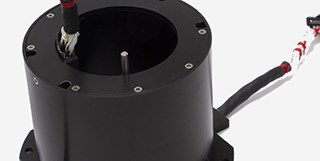
Radar
Radars in defence applications can vary widely.
A target acquisition radar in the nose of an air combat fighter will be fairly small, light and work for fairly short periods.
A radar in an AWACs aircraft will be larger, use more power, and handle more complex data. While remaining light it will have a longer time in continuous use.
A ship-mounted radar will have fairly complex power and data handling needs within mass and space constraints and its protection from salt water penetration will be very important.
Ground-based military radars may use so much power that they will need a hydraulic rotary joint inside the slip ring so that the radar’s electronics may be cooled. It is quite likely that the slip ring may also carry a rotating microwave joint, both wave guide and co-axial. Additionally this radar may be mounted on a lorry that moves over rough terrain so it will be subjected to vibration and shock loads and it too will have mass constraints.
In its many decades of design and supply of military-specified radar slip rings Pandect has frequently overcome all of these challenges for customers in the UK, Continental Europe and Asia.